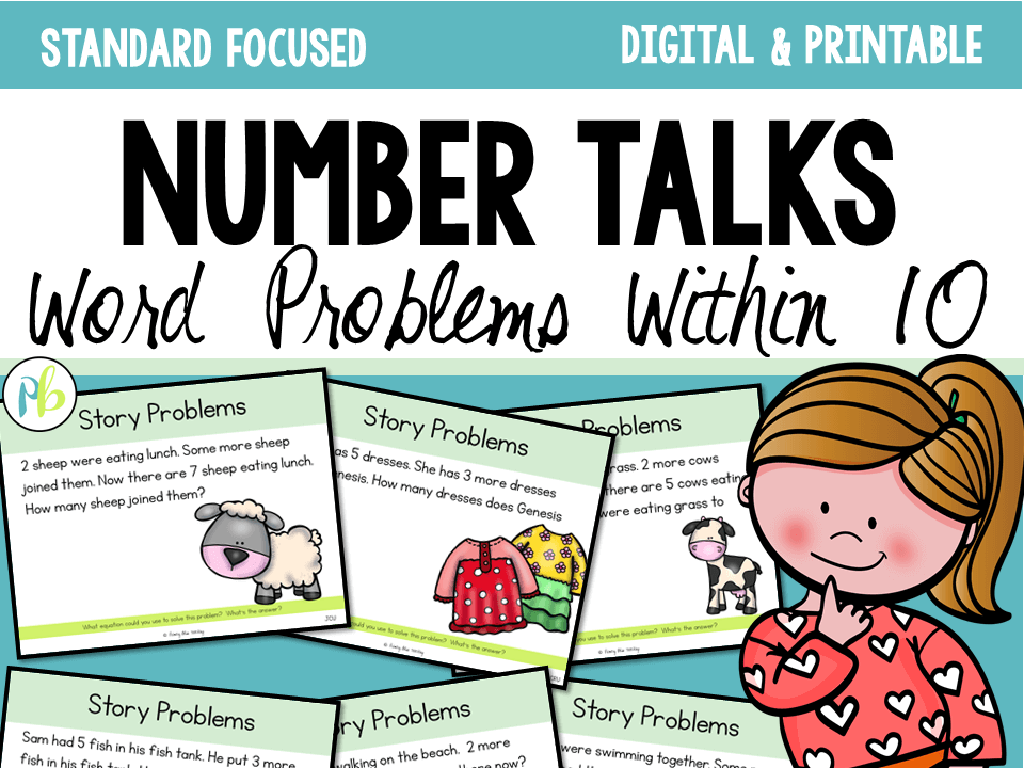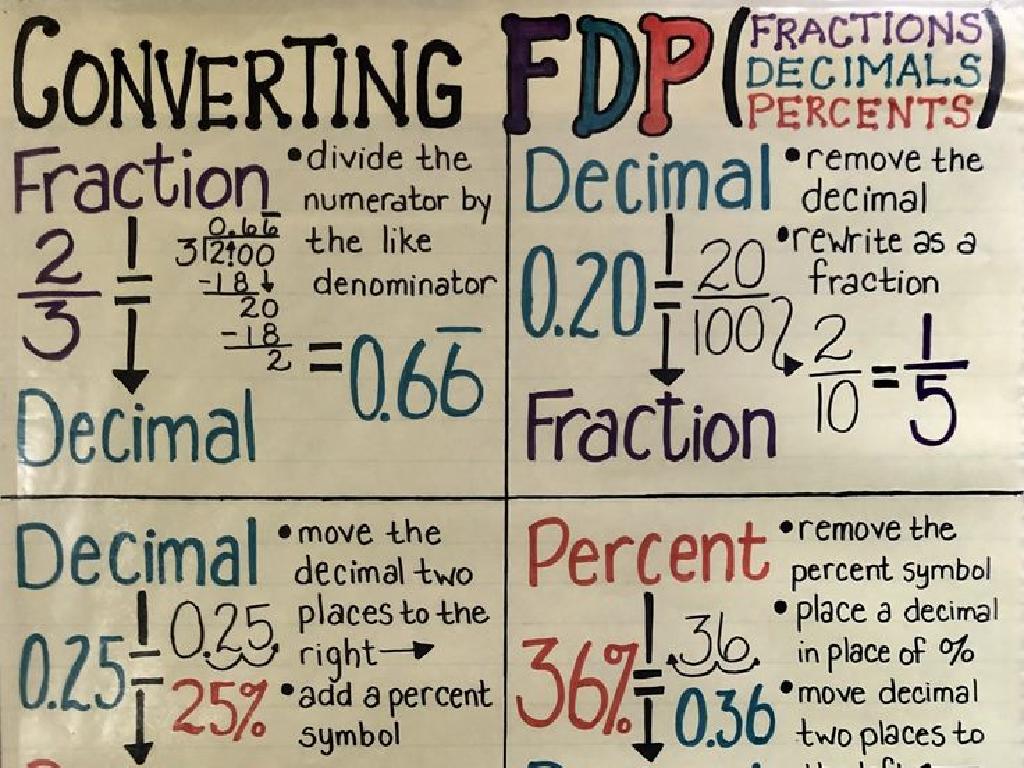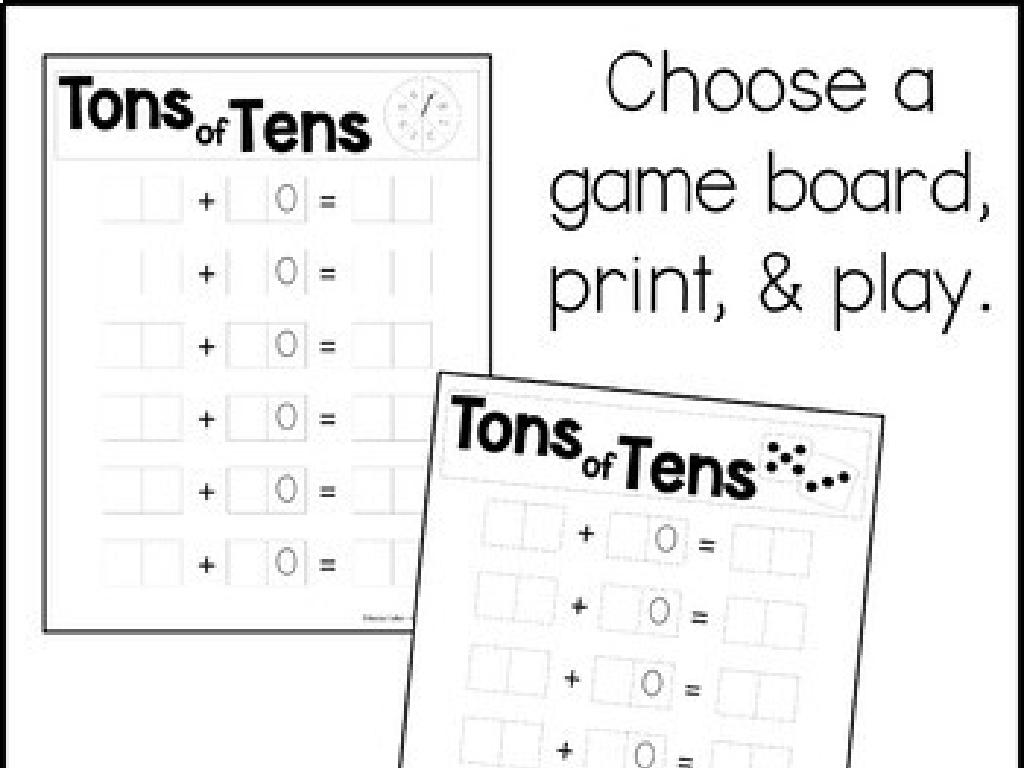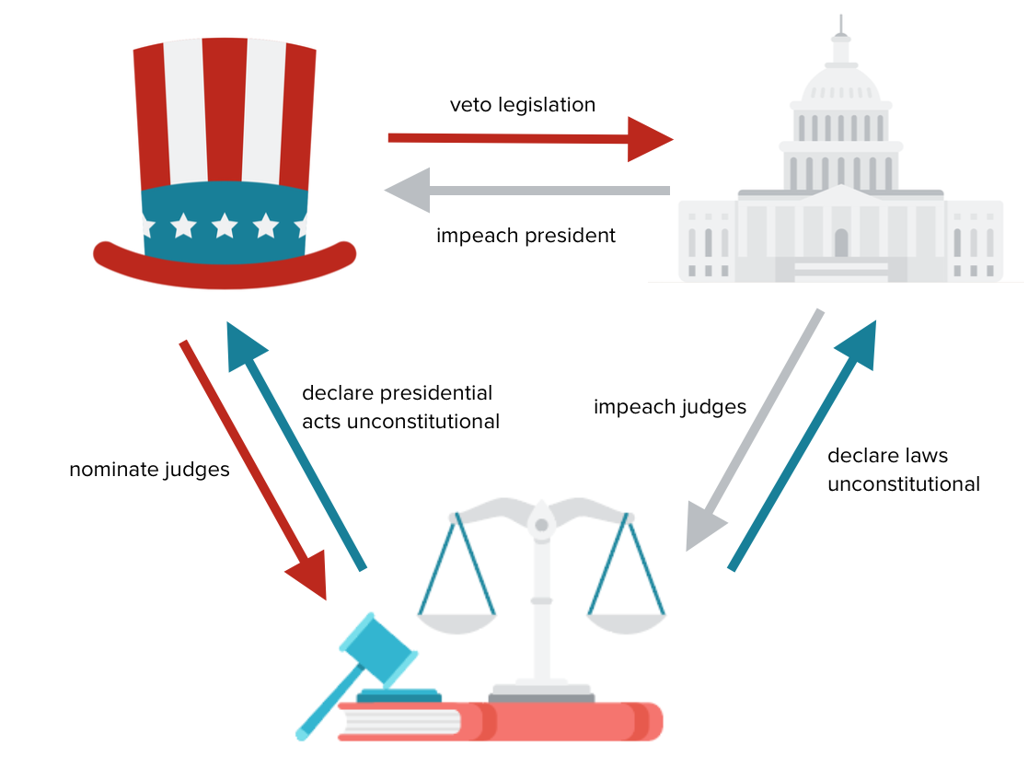Convert Fractions And Mixed Numbers To Decimals - Denominators Of 10 And 100
Subject: Math
Grade: Fourth grade
Topic: Relate Fractions And Decimals
Please LOG IN to download the presentation. Access is available to registered users only.
View More Content
Converting Fractions to Decimals
– Understanding fractions and decimals
– Fractions show parts of a whole; decimals show them in another way.
– Everyday use of decimals
– When shopping, checking the time, or measuring.
– Today’s goal: conversion
– Learn to change fractions like 1/10 or 3/100 into decimal form.
– Practice with denominators 10, 100
– Use examples like 1/10=0.1 and 3/100=0.03 to demonstrate.
|
This slide introduces the concept of converting fractions with denominators of 10 and 100 to decimals, a key skill in fourth-grade math. Start by explaining the relationship between fractions and decimals, emphasizing that they are two ways of expressing the same idea. Highlight the practical applications of decimals in everyday life, such as money and measurements, to make the lesson relatable. The goal for today’s class is to ensure students understand how to convert fractions and mixed numbers with specific denominators into decimal form. Provide plenty of examples and practice opportunities, such as converting 1/10 to 0.1 and 3/100 to 0.03, and encourage students to think of other examples where they encounter decimals daily.
Understanding Fractions
– A fraction is part of a whole
– Numerator and denominator explained
– Top number (numerator) / Bottom number (denominator)
– Example: 1/2 as a fraction
– 1/2 means 1 out of 2 equal parts
– Converting to decimals
– 1/2 equals 0.5 because 50 is half of 100
|
Begin the lesson by explaining that a fraction represents a part of a whole, like a slice of pizza out of a whole pizza. Clarify the terms numerator and denominator, where the numerator indicates how many parts we have and the denominator shows into how many equal parts the whole is divided. Use the example of 1/2 to illustrate a simple fraction, explaining that it means one out of two equal parts. Then, demonstrate how to convert this fraction into a decimal by dividing the numerator by the denominator, which in the case of 1/2 is 0.5 because 50 is half of 100. This will set the foundation for understanding how to convert fractions with denominators of 10 and 100 into decimals.
Understanding Decimals
– Decimals represent parts of a whole
– Decimals are based on the number 10
– Example: 0.5 equals 1/2
– Half of a dollar is 50 cents, or $0.5
– Converting fractions to decimals
– Divide the numerator by the denominator
|
This slide introduces the concept of decimals to fourth-grade students, explaining that decimals are another method to represent fractions. Emphasize that the decimal system is based on the number 10, which relates to our everyday counting system. Use everyday examples, such as money, to illustrate the concept of decimals, making it more relatable and easier to understand. For instance, show that half a dollar, which they know as 50 cents, can also be written as 0.5. This sets the stage for teaching them how to convert fractions with denominators of 10 or 100 into decimals by dividing the numerator by the denominator. Provide several examples and practice problems to reinforce the concept.
Converting Fractions to Decimals
– Special fractions with 10 or 100
– Easy conversion to decimals
– Example: 1/10 equals 0.1
– Move the decimal one place to the left for 10
– Example: 3/100 equals 0.03
– Move the decimal two places to the left for 100
|
This slide introduces students to the concept of converting fractions with denominators of 10 or 100 into decimals. Emphasize that these denominators are special because they correspond to our base-10 number system, making conversion straightforward. Show that for a denominator of 10, we move the decimal point one place to the left, and for a denominator of 100, we move it two places to the left. Provide additional examples like 7/10 = 0.7 and 25/100 = 0.25 to reinforce the concept. Encourage students to practice with different fractions and to check their understanding by converting decimals back into fractions.
Converting Fractions to Decimals
– Divide numerator by denominator
– Decimal point with denominators 10, 100
– Move the decimal left for 10, more for 100
– Example: Convert 7/10
– 7 divided by 10 is 0.7
– Example: Convert 46/100
– 46 divided by 100 is 0.46
|
This slide introduces the concept of converting fractions to decimals, specifically for fractions with denominators of 10 or 100. Start by explaining that the numerator (top number) can be divided by the denominator (bottom number) to find the decimal equivalent. Emphasize that when the denominator is 10 or 100, it’s even easier – we can simply move the decimal point to the left by one place for 10, or two places for 100. Use the examples of 7/10 and 46/100 to illustrate this point. For 7/10, since the denominator is 10, we move the decimal one place to the left, giving us 0.7. For 46/100, we move the decimal two places to the left, resulting in 0.46. Encourage students to practice this method with different fractions to become comfortable with the process.
Converting Mixed Numbers to Decimals
– Understanding mixed numbers
– A mixed number combines a whole number with a fraction
– Converting fraction to decimal
– Divide the numerator by the denominator
– Adding decimal to whole number
– Add the decimal fraction to the whole number
– Example: 3 1/10 to decimal
– 3 1/10 = 3 + 0.1 = 3.1
|
This slide is aimed at teaching fourth graders how to convert mixed numbers with denominators of 10 or 100 into decimals. Begin by explaining what a mixed number is, emphasizing the presence of both a whole number and a fraction. Demonstrate the conversion process by dividing the numerator by the denominator to convert the fraction into a decimal. Then, show students how to add this decimal to the whole number part of the mixed number. Use the example of converting 3 1/10 to a decimal to illustrate the process step by step. Encourage students to practice with additional examples and ensure they understand that denominators of 10 or 100 make it easy to convert to decimals since they align with the place value system in decimals.
Let’s Practice Together: Converting Fractions
– Convert 2/10 to a decimal
– 2/10 is the same as 0.2
– Convert 5/100 to a decimal
– 5/100 is the same as 0.05
– Convert 4 7/100 to a decimal
– 4 7/100 is the same as 4.07
|
This slide is designed for a class activity where students will practice converting fractions with denominators of 10 and 100 into decimals. Start by explaining that the denominator indicates the decimal place: for example, 10 means one decimal place, 100 means two decimal places. Then, guide students through the conversion process: 2/10 becomes 0.2 because 2 is in the tenths place; 5/100 becomes 0.05 because 5 is in the hundredths place. For mixed numbers like 4 7/100, show students how to convert the fractional part to a decimal and then add it to the whole number, resulting in 4.07. Encourage students to work through these examples and come up with similar fractions to convert. Provide immediate feedback and support as needed.
Fraction and Decimal Bingo
– Receive your unique Bingo card
– Listen for the called decimal
– Find the matching fraction
– Use your skills to convert decimals to fractions with denominators of 10 or 100
– Aim for five in a row to win
|
This class activity is designed to reinforce the concept of converting fractions and mixed numbers to decimals with denominators of 10 and 100. Each student will receive a Bingo card populated with a mix of fractions and decimals. As the teacher calls out a decimal, students must use their conversion skills to find the equivalent fraction on their card and mark it. The first student to align five correct conversions in a row, either horizontally, vertically, or diagonally, will call out ‘Bingo!’ The teacher will then verify the accuracy of the conversions. This game encourages active participation and provides a fun, competitive way to practice the lesson’s objective. Prepare several variations of the Bingo cards to ensure a unique experience for each student. Possible activities for different students could include creating their own Bingo cards with fractions and decimals, working in pairs to find matches, or even calling out the decimals for their peers.
Converting Fractions: Homework
– Congratulations on learning conversions!
– Homework: Worksheet on conversions
– Complete the provided worksheet at home
– Practice converting fractions to decimals
– Focus on fractions with denominators of 10 or 100
– Aim for perfection through practice
|
This slide marks the conclusion of the lesson on converting fractions and mixed numbers to decimals. The homework assignment is a worksheet that will provide students with additional practice to reinforce their understanding of the concepts taught in class. Emphasize the importance of practice in mastering these conversions, especially with fractions that have denominators of 10 or 100, as these are directly related to the decimal system. Encourage students to approach the worksheet with a positive mindset, aiming for accuracy and understanding. Remind them that making mistakes is a part of learning and that with each attempt, they are getting closer to perfection.






